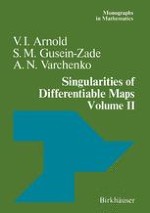1988 | OriginalPaper | Buchkapitel
Asymptotics and Newton polyhedra
verfasst von : V. I. Arnold, S. M. Gusein-Zade, A. N. Varchenko
Erschienen in: Singularities of Differentiable Maps
Verlag: Birkhäuser Boston
Enthalten in: Professional Book Archive
Aktivieren Sie unsere intelligente Suche, um passende Fachinhalte oder Patente zu finden.
Wählen Sie Textabschnitte aus um mit Künstlicher Intelligenz passenden Patente zu finden. powered by
Markieren Sie Textabschnitte, um KI-gestützt weitere passende Inhalte zu finden. powered by
We shall consider the class of critical points of the phase, the Taylor series of which have fixed Newton polyhedron. If the Newton polyhedron is remote, then almost all the critical points of the class have the same oscillation index. This common oscillation index is equal to the remoteness of the Newton polyhedron. A critical point of the class has the typical oscillation index if the principal part of its Taylor series is ℝ-nondegenerate. (Remember that the condition of ℝ-nondegeneracy is an explicitly written-out algebraic condition on a finite set of Taylor coefficients, see § 6.2). This assertion was formulated as Theorem 6.4. Its proof occupies the whole of the present chapter. The proof uses the resolution of the singularity of the critical point of the phase. In the previous chapter we defined a numerical characteristic of the resolution of a singularity, namely the weight, and we proved that if the weight is greater than —1 then the oscillation index of the critical point is equal to the weight (Theorem 7.5). In this section we construct a manifold and a map of it into ℝn, which resolves the singularity of almost all the critical points of the class we are considering. We shall show that the weight of the constructed resolution of the singularity is equal to the remoteness of the Newton polyhedron. In this way we shall prove Theorem 6.4.
